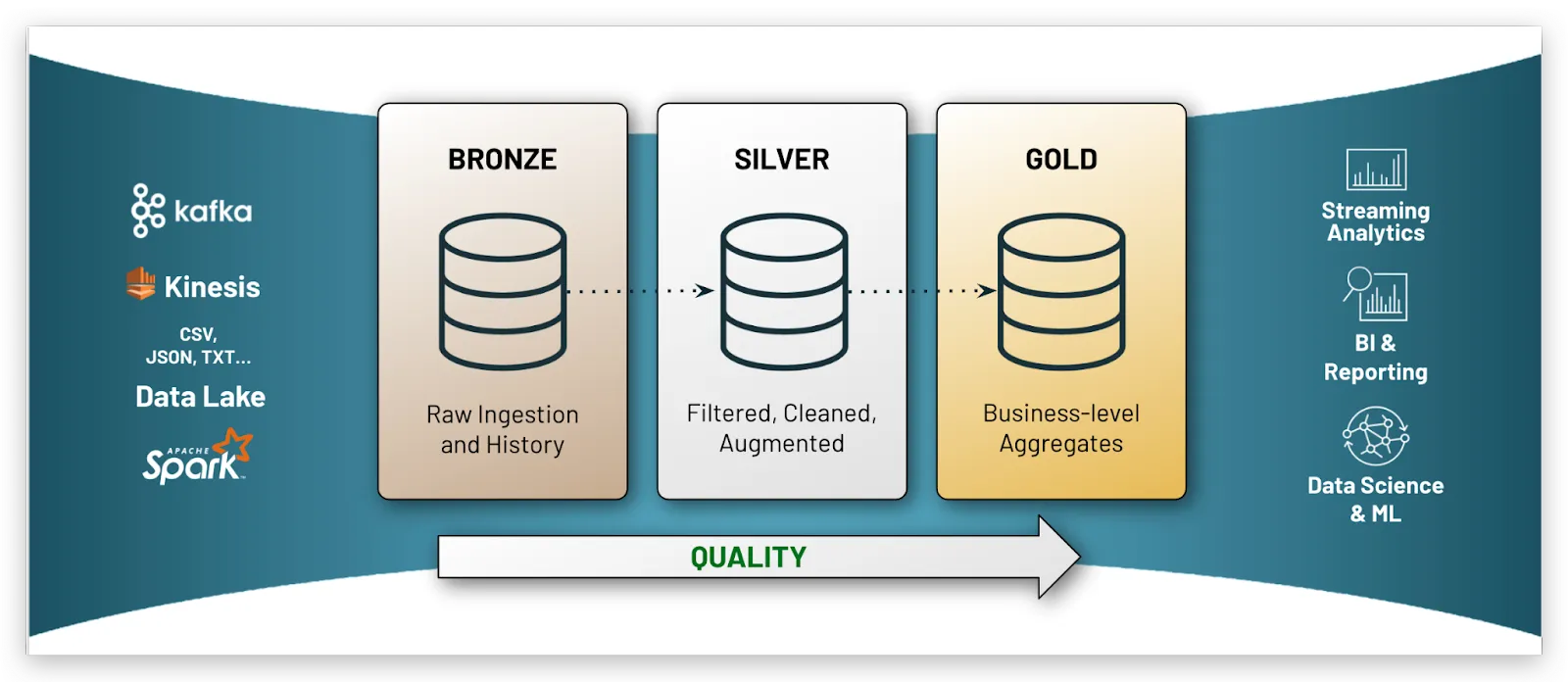Organizations are continuously searching for effective solutions to store, handle, and analyze vast volumes of data in the age of big data and advanced analytics. An effective and adaptable method for organizing data inside a data lake is the Medallion Architecture, which provides a methodical strategy to managing unprocessed data and turning it into insights that can be used. This architecture is a well-liked option for contemporary data engineering since it enables enhanced data quality, performance, and scalability.
What is Medallion Architecture?
Medallion Architecture is a design framework used in data lakes that organizes data into multiple layers, each serving a specific purpose. It is named for the way it structures data in a tiered, “medallion” fashion, typically consisting of three main layers: Bronze, Silver, and Gold.

Figure: Medallion Architecture in a nutshell
Bronze Layer (Raw Data)
Data is first ingested into the data lake through the Bronze layer, also known as the raw or raw ingestion layer. The unprocessed, raw data is contained in this layer and comes from a variety of sources, including log files, databases, APIs, and external data providers. This layer’s main objective is to gather and retain data in its most raw form, without any kind of modification.
Key characteristics of the Bronze layer:
– Raw and Unmodified:
The data is stored as-is, preserving its original format and structure.
– High Volume:
This layer can handle large volumes of data, including structured, semi-structured, and unstructured formats.
– Durability and Reliability:
It ensures that the original data is preserved for future processing or reprocessing.
Silver Layer (Cleansed and Conformed Data)
Data is transferred to the Silver layer for processing and modification once it is ingested into the Bronze layer. Purifying, screening, and standardizing the data are all part of the Silver layer’s process to guarantee that it is excellent and consistent throughout the dataset. Usually, data integration, validation, and cleansing are done at this step.
Key characteristics of the Silver layer:
– Data Quality:
This layer focuses on improving data quality by handling missing values, correcting errors, and standardizing formats.
– Integration:
Data from various sources is integrated and conformed to create a unified dataset.
– Intermediate Storage:
It serves as an intermediate storage for further analytical processing.
Gold Layer (Aggregated and Refined Data)
The last phase of data processing, known as the “Gold layer,” is where data is combined, cleaned, and prepared for more sophisticated reporting and analytics. Typically, the data at this layer is highly structured and tailored to certain use cases or business requirements.
Key characteristics of the Gold layer:
– High-Value Insights:
This layer is designed to provide actionable insights and support decision-making.
– Aggregated Data:
It often includes aggregated metrics, summarized reports, and refined datasets tailored to specific business requirements.
– Performance Optimization:
The data is optimized for performance to support fast query responses and complex analytics.
Benefits of Medallion Architectur
The Medallion Architecture is an appealing option for data lake construction because it provides several advantages.
Improved Data Quality:
Organizations can systematically raise the quality of the data they use for analysis by breaking up data processing into discrete levels and making sure that only clean, refined data is used.
Scalability:
By handling data at various granularities, the architecture facilitates scalability. Every layer can be scaled individually to accommodate growing loads as data quantities increase.
Flexibility:
Without altering the raw data in the Bronze layer, organizations may quickly adjust or add processing stages in the Silver and Gold layers to accommodate changing business requirements.
Performance Optimization:
The Gold layer’s processing and aggregation of data optimizes query performance, resulting in quicker and more effective analytics.
Separation of Concerns:
Because each layer of the Medallion Architecture focuses on a different facet of data administration and processing, there is a clear separation of concerns. Data maintenance and governance are made easier by this separation.
Conclusion
A methodical and effective way to manage data in a data lake is offered by the Medallion Architecture. Businesses may efficiently collect unprocessed data, improve the quality of their data, and provide insightful information by layering their data into Bronze, Silver, and Gold categories. Scalability, adaptability, and performance optimization are all supported by this architecture, which makes it an effective foundation for contemporary data engineering and analytics. With companies continuing to use big data for competitive advantage, the Medallion Architecture is a reliable way to handle the challenges associated with data management.

